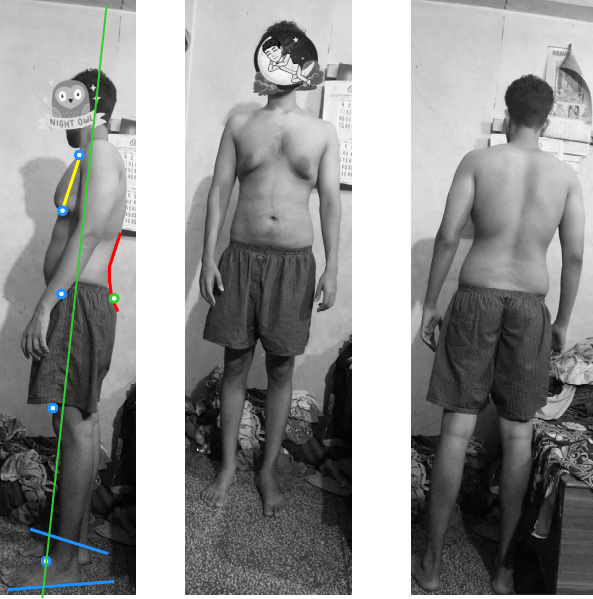
Look, it was quite hard to set the plumb line correctly on the first image. It was literally impossible on the posterior and anterior views
Camera isn't horzinotal, and there is very few vertical lines at the backround to use them as reference.
But, the side view is close enough i'd say.
Let me talk you through it.
first feet, they are in wrong position. heels together, toes apart.
the blue lines (outsteps - the outside of your foot) should be parallel.
no, not yet, let me first talk you throu what is visible. if we need more clarification, you can take more pics then.
also, on every picture you have provided, you will notice that you place your left foot ahead of your right.
quite a bit, almost an inch.
that means, that there will be left / right imbalances and twists through out the mechanism in order to satisfy your equilibrium.
knees are not in full extension (released)
pelvis slighty tilted anteriorly, that means you are pushing your iliacs (the blue dot at your waist height).
and at the same time, (as it's the same bone / structure) you are lifting your sacrum up (green dot).
let's call this rotation "Anticlockwise".
then, your upper torso (ribcage).
that is rotated exactly the opposite to the pelvis
that is you are leaning backwards with the top of your ribcage and pushing the bottom forwards.
the slant of the yellow line shows the incline (your sternum is a part of the ribcage).
Let's call the rotation of your upper ribcage "clockwise".
so now, you have 2 entities (pelvis and ribcage), which are rotating towards each other in opposing directions.
now, between these to entities, there is highly articulated entity - spine.
And the spine is curved (red) as a result of these two rotations.
If you would be to flip these rotations, that is to get the ribcage rotate anticlockwise and the pelvis clockwise, it would result in straigthening your spine between, and that is what we would like.
In order to have a mechanism of torso that operates most efficiently, you would basically need to shift all of the blue markers onto the green line.
that way, you would flatten the curve in your lowerback, loose the belly.
BTW, your belly isn't there because you are fat. It's there because your abdominal muscles are completely out of action, not supporting your torso and just basically spilling out at the front.
The only way to adjust the spine curve would be to engage the muscles in your belly, and you puff, just like that it would be gone.
And then the position of your arms. They are retracted too far back.
Also, if you look at the front / back view and compare the void between your arms and your body, you will see differences.
This is due to the feet not being square - which then translates right through your system.
your iliacs aint' square either and neither are your shoulders and your neck.
The curve in your back is what we call "shortening and narrowing of your torso". If you would be to change this for the better, a lot of your left / right imbalances would get automatically sorted out as a result, and what ever didn't get sorted, you would then be able to correct by focusing on the left / right issues. But the main problem is the shortening of the torso.
In other words, if you don't fix the shortening in your torso first, you will never be able to fix the L/R twists.
The twist are hard to detect. You would have to be square to a wall with your feet, have a camera that is also square and probably you would have to use rulers to judge the distances to be sure.
You can try it yourself - stand about 50 cm away from a wall.
now, you have to options - you can focus on squaring your upper part of your body including head untill you are happy, and then have a look at your feet / legs / iliacs, they will NOT be squared.
Or you can force yourself to stand with your feet square to the wall, and then look up and you will see in your peripheral vision that something is "off" at the upper torso.
Basically, you will find it's near impossible for you to stand fully square in front of a wall.
Well, it's not impossible. It's possible, but your habitual movements will not allow for that immediately.
I hope that helps.